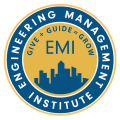A Quick Note Before We Start
I coach engineering managers every day. Before that, I was an engineer, and then I spent 10 years recruiting engineers. I’ve sat in hundreds of 1:1s, debriefs, and hiring loops, and I’ve had 1000s of tough conversations. What I’m sharing here isn’t theory. It’s a simple emotional intelligence system I use with clients to make “emotional intelligence,” or what I like to call, EQ, real at work. No jargon, no lectures, just practices you can run weekly.
Why Turn EQ Into a System?
At the Engineering Management Institute, the focus is on helping engineers lead people and projects better. That means turning soft ideas into clear actions. Reliability in a system doesn’t happen by accident; you instruct, observe, and respond. Team health works the same way. If you track a few signals and run the same small habits every week, trust goes up, work moves faster, and people stay longer. This is about making an emotional intelligence system useful, not fuzzy.
Step 1: Watch 3 simple signals
Keep it light and repeatable. In every weekly 1:1, ask 3 questions and write down short answers in a shared doc:
- Energy: How was your energy this week (high, medium, or low)? Why?
- Blockers: What people or process issues slowed you down?
- Clarity: Were priorities clear? If not, what was confusing?
That’s it. After 4 to 6 weeks, patterns jump out. Maybe energy dips after handoff day. Maybe “unclear priorities” appear every time you start a new project. You can’t fix what you can’t see. These signals help you see early.
Step 2: Keep a tiny friction log
Any time a design review turns tense or a meeting derails, log the moment. Just the basics: when it happened, who needed what, and one likely cause (role confusion, unfair workload, vague expectations). No blame. No drama. You’re just collecting data so you can fix repeat issues.
Step 3: Write short decision notes
Confusion grows in silence. For any decision that affects more than one person, post 3 lines in the team channel:
- Owner: Who decides?
- Why now: What’s the reason or deadline?
- Trade-offs: What did we consider and skip?
These notes cut second-guessing and help engineers move without waiting. When new info arrives, you can change course quickly because the “why” is already written down.
Step 4: Use small runbooks when signals trip
Here’s how I coach engineering managers to respond:
- Energy is low 2 weeks in a row → Book a focused 1:1 within 48 hours. Ask, “What’s one thing I can remove this week to help?” Remove it. Report back.
- PR fights keep showing up in the friction log → Reset review rules in writing: what “blocking” means, who breaks ties, and by when.
- Priorities feel fuzzy → Share a one-page sprint brief: what we’re doing, why it matters now, and what can slip. Pin it on the wall. Refer to it daily.
A Senior Technical Program Manager I interviewed to write this article told me: “I prefer to treat a blow-up like an incident. As soon as it happens, I schedule a short, blameless review within 3 days. I like to document what happened, how it hit my work, one thing that would have prevented it, and one change I’ll try next time to prevent the blow-up from happening again. Then, I’ll check next week’s signals to see if it helped.”
Step 5: Track only 3 metrics
You don’t need a dashboard jungle. 3 numbers are enough:
- Time to decide: How long from debate to call? If it keeps growing, tighten roles and improve decision notes.
- Rework on performance reviews: Lots of back-and-forth usually means unclear standards, not lazy engineers.
- Early I might “leave” signals: More missed 1:1s, rising sick days, sudden LinkedIn activity. These aren’t perfect, but they tell you to lean in now.
Look at trends monthly. Don’t overreact to a single bad week.
How This Looks in Real Life
Amanda, a senior engineering manager I coached earlier this year, kept seeing “unclear priorities” in weekly notes. Nothing was “on fire,” but work was slow and the engineers in her team were snappy in reviews. I proposed adding a 10-minute mid-week ritual: she posted a simple sprint brief with 3 bullets: top goals, why they matter now, and what can slip. We also set a rule that any new “urgent” item had to replace something on the list. Within a few sprints, rework dropped, and her team hit their demo dates. No big speeches. Just a habit.
Rohit, the Technical Program Manager I mentioned above, had repeated tension in progress reviews. We used the friction log to see the pattern: 2 Project Managers using “blocking” for style preferences. We wrote a tiny review runbook and defined “blocking” as only issues that risk deadlines. Everything else became “recommended.” The change cut review time by a third and the tone improved.
Common Mistakes (And What I Do Instead)
The first mistake is trying to track everything. If it takes more than 15 minutes a week, it won’t last. I cap the whole system (signals, log, notes) at that limit. The second mistake is turning reviews into blame sessions. That shuts engineers down. Keep them short, factual, and focused on the next action. The third mistake is mixing empathy with approval. You can care about someone and still hold the line on quality, safety, compliance, and deadlines. I often say, “I hear you’re stretched. The standard stays the same. What can we drop to meet it?”
A Simple 30-60-90 Day Action Plan
- Days 1–30: Add the three weekly questions and the friction log. Share one decision note per week. Keep it scrappy. Keep it visible.
- Days 31–60: Run two blameless reviews for people issues. From each, ship one change (a checklist, a pre-read, a clearer owner). Tell the team what you changed and why.
- Days 61–90: Track your three metrics month to month. Set one goal, like “cut time to decision by 20%.” If a habit doesn’t help, stop it. If one helps, lock it in.
One Last Thought From an Engineering Career Coach
An emotional intelligence system isn’t a nice-to-have. It’s a way to make work smoother when the load gets heavy. You can build it like any other system: start small, measure what matters, and improve it every week. If you try this for a month, tell me what changed. What signal surprised you? What small habit made the biggest difference? I’ll share back what I’m seeing with my other coaching clients, so we all get better together.
About Nader Mowlaee:
Please leave your comments, feedback or questions in the section below.







